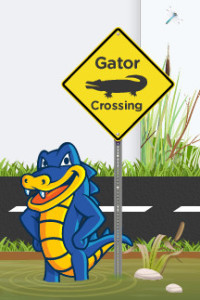So I’m sure there are a lot of sites that can help you create a blog, what I want to detail here is for you to have a blog like this one. So it’ll be more of an introspection than a how to, but hopefully at the end you’ll say “YES, I can do this.”
The Idea
So I started with 2 ideas in mind: create a site for the family and create a site for my own personal posts. I’ll focus my efforts on this personal blog, so the big Idea for this personal blog was a way to tie my online presence into one location.
In essence, this site needed to do 3 things for me:
- Hold a current copy of my resume
- Hold a place where I could write in any format that I wanted and not be restricted in any way
- Showcase the work that I do
The Domain Name and Hosting
 So now I was ready to search for a domain name and hosting; basically your address and where your information will reside. There are many companies that that provide provide both, or just one of those services. I picked HostGator, just because it offered all that I needed for a low price. So far I don’t have any complaints, but my traffic is low.
So now I was ready to search for a domain name and hosting; basically your address and where your information will reside. There are many companies that that provide provide both, or just one of those services. I picked HostGator, just because it offered all that I needed for a low price. So far I don’t have any complaints, but my traffic is low.
Once you decide on your providers, just search for the Domain Name that you want. I wanted Mijangos.com; but couldn’t get it. I ended up deciding on FamMijangos, short for both Familia and Family. The Hosting will give you a back door to your site allowing you to make changes in a very deep level; think of it as the operating system, and your actual site as an application.
Go with the default settings, they almost always will allow you to start where you need to be. Also know that with the hosting you’ll get other things that you may or may not want: email addresses, sub-domains, forwards, etc. If none of that make sense, don’t worry.
For this site I did want a sub-domain, notice that you are in arturo.fammijangos.com and not just fammijangos.com. That was something that I needed, but not necessary.
The Platform
 The platform is the application that will be running your blog, there are different ones each with its Pro’s and Con’s. I chose WordPress (WordPress.org not WordPress.com) because I had some basic understanding of how it worked from a class I took in college. Choose something you feel comfortable doing, and that you don’t mind taking a deeper look into.
The platform is the application that will be running your blog, there are different ones each with its Pro’s and Con’s. I chose WordPress (WordPress.org not WordPress.com) because I had some basic understanding of how it worked from a class I took in college. Choose something you feel comfortable doing, and that you don’t mind taking a deeper look into.
You’ll need to set up the platform from within the Hosting backdoor, it will create the basic template and give you a username and password. You will then go to your domain and it will ask you to log in using the username/password combination.
Your site will look vary plain, it’s meant to be that way. It will have a very plain theme, which is like the underwear. Just something plain, functional and begging to be dressed.
The Theme

So then next big thing is the theme. The theme is the dress you put on your site, it will add functionality and make your site look nicer. The theme also gives your site a personality, but creating a consistent color palette and formatting scheme. There are many, many, themes to choose from. I went with the Esplanade theme from One Design as it looked good and was simple. Do try a few themes, don’t do customization, just try them on and see which one is more you than others. Look for simple ones if you intend to do customization, because you’ll find that they are easier to understand.
The Look
Customization
So you got your site dressed, but you want the coat just a little bit bigger. You want the same pants, but with a different color. Those are customizations, and you will need to get your hands into some of the guts of wordpress. If you are comfortable with some coding in PHP and CSS, then this is for you, if not just leave the theme the way it is. The best way to customize is to use child themes, if not, every time you update the theme you will lose your customizations.
Widgets
Continuing with the metaphor, widgets are your accessories. They provide additional information around the main content. There are many widgets to choose from, but use them sparingly. The biggest drawback from using too many is that some are not coded correctly and can have bugs that crash your whole site. I use one for the recent posts and one for the tag-cloud.
Plugins
Plugins give you additional functionality, most of them have to visual impact on your site. They will be important if you want to import posts from other sites/platforms. I also like Jetpack, which gives you tons of functionality from wordpress.com. I use WPResume to post and manage my resume. The others one is WP Super Cache which come by default.
The Backlog
So this was not my first try at doing a blog and so I had a Tumblr account and a Blogger account. They had old posts, that although were not that pertinent did bring some value. One really good thing is that if you import, you automatically have things to play around with. You won’t really see how your site looks until you have older posts with different formats. You can later update the tags or headlines, but you aught to have some history.
The Content
This is the heart of your blog, and you become the content director, editor in chief, editor, reviewer and author. Decide based on your idea what will bring the most value to your audience. Each post will be a reaffirmation to that idea; a piece of the puzzle. I break each post into 4 pieces, unless you actively think of those pieces they won’t magically appear.
Idea
Each post should have a purpose, an idea that you want to convey through words. I will many times read an article and think, I should write about it, but then I can’t think of something to contribute. You can also think of a post as documenting something, there will be an audience that is interested in what you do. Do be mindful of the audience and the message.
Format
Now that you have your idea you need to decide how you will express that idea. Will you do it just through words, or do you need pictures. You may decide to only use photographs or a video. You could mix a few elements together. I use mainly words and a few images; for my family blog I use more images.
Content
Now it is time to write. You will not be perfect, but you need to put words down. I like to make an outline of what I want to write. So I just start writing short sentences and hitting return. Some of those sentences grow later to headings or paragraphs. Don’t fear what others will say, at this point you are on brainstorming mode and anything goes.
Go at it in iterations. Do a brainstorm and write as much as you can. Then be more of a fill in the gaps and flesh out those areas that will be meaningful to you and your audience. Do a sanity check and verify if your ideas are valid; and your intent is captured in your words. Finally go about it as an editor, look for mistakes in your writing; if you can have someone else proof read it that would be great. Finally look at it as an editor in chief, does that post go along your main purpose of the site? Is it too personal to put on your professional blog? In the end, you are the boss and you decide.
Imaging
I like to do my imaging before the content, but there are post where there is little imaging and you want to write first. Imaging is important, specially in a blog because most internet users are turned off by pure test. There has to be a good balance to how much images you want to use. By this point you have a good understanding of where and what you want to use (format), but the actual image is sometime difficult to find.
Publishing
Before publishing make sure that you preview your post. All links should work as intended, the images should look good. If you have a way to see it on different machines try it, that will allow you to see how others see your site.
Set all the right categories that help people find the information quickly. Set any tags that you think are pertinent to the post. Set a picture or image as featured if your theme allows it.
Now hit Publish and go check out your work.
The Fallout
Promotion
Creating the content is much different than creating the audience, or finding the right people that want to consume the content you provide. Social media provides a good audience to determine who to share your content. When I write on my family blog, I share the post on facebook where family and friends might click to find out my latest adventure. If I write about my career or my work posting to my MBA group on Linkedin, where people will care about what I write.
WordPress allows to connect directly social media and to make those posts; I personally don’t like that. I want to be more deliberate in how I share my content, this way people will want to visit your blog for the information they care about.
Tracking
One important aspect will be to track the people that come to your site. You want to find out how many people visit your site and which posts they gravitate to. Most of this information you can get it from the Jetpack plugin. You can also add your site to Google Analytics, but that is a topic for another post.

